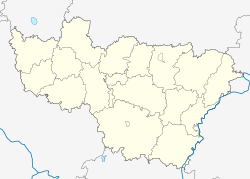유클리드 공간 에서 점에서 평면까지의 거리 는 주어진 점과 평면의 직교 투영 또는 평면의 가장 가까운 점 사이의 거리다.
주어진 점과 일치하도록 원점을 이동한 다음 이동 평면 에서 원점 에 가장 가까운x b y c {\displaystyle ax+by+cz=d} 변수의 변화 로 시작할 수 있다. 결과 점에는 데카르트 좌표 (x y z {\displaystyle(x,y,z)} :
x = d a 2 b 2 c 2 b a 2 b 2 2 z c d a 2 c 2 {\ displaystyle x={\frac {ad}{a^{ a^}+b^{2}+c^{2 } }}}},\c^ \property \displaystyle y={\frac {bd}{a^{2}+b^{2}+c^{2 } }}}},\c^ \c^ \displaystyle z={\frac {cd}{a^{2}+b^{2}+c^{2 } }}}} 원점과 점 사이의 거리 x , , {\displaystyle(x,y,z)} ( x 2 2 z 2 displaystyle {\sqrt {x^{2 y^{2}+z^{2 }}}}
일반 문제를 원거리 문제로 변환하는 중 평면에서 점(X 0 ,Y , Z 0 {\ displaystyle X_{0}) Y_{0},Z_{0}} a X + b Y + c Z = D {\displaystyle aX+bY+cZ=D} x = X − X 0 {\displaystyle x=X-X_{0}} y = Y − Y 0 {\displaystyle y=Y-Y_{0}} z = Z − Z 0 {\displaystyle z=Z-Z_{0}} d = D − a X 0 − b Y 0 − c Z 0 {\displaystyle d=D-aX_{0}-bY_{0}-c Z_{0}}} ( x b y c {\displaystyle ax+by+cz=d} 이제 문제는 이 평면에서 출발지와 가장 가까운 지점, 그리고 출발지와의 거리를 찾는 것의 하나가 되었다. 원래 좌표와 관련된 평면상의 점은 위의 x {\displaystyle x} {\displaystyle X} , y {\displaystyle y} Y {\displaystyle Y } z {\ displaysty z} } 원래 좌표의 ms는 수정된 좌표의 측면에서 거리와 동일하다.
선형대수를 이용한 재작성 기원에 가장 가까운 점에 대한 공식은 선형대수 의 표기법을 사용하여 보다 간결하게 표현할 수 있다. The expression a x + b y + c z {\displaystyle ax+by+cz} dot product ( a , b , c ) ⋅ ( x , y , z ) {\displaystyle (a,b,c)\cdot (x,y,z)} a 2 + b 2 + c 2 {\displaystyle a^{2}+b^{2}+c^{2}} norm ( a , b , c ) 2 {\displaystyle (a,b,c) ^{2}} v = ( a , b , c ) {\displaystyle \mathbf {v} =(a,b,c)} w {\displaystyle \mathbf {w} } v ⋅ w = d {\displaystyle \mathbf {v} \cdot \mathbf {w} =d} 또는
p v d 2 {\ displaystyle \mathbf {p} ={\frac {\mathbf {v}d [1] [2] mathbf {v}{2}}. 원점에서 평면까지의 유클리드 거리 는 이 지점의 표준이다.
d v = d a b 2 2 {\ displaystyle {\frac {}{\mathbf {v}}}}}:{\frac {}}}{\sqrt {a^{2}+b^{2+c^{ 2}+c^{2 } }}}}} 왜 여기가 가장 가까운 지점인가? 좌표 또는 벡터 제형 중 하나에서, 평면의 방정식에 점을 연결함으로써 주어진 점이 주어진 평면에 있는지 확인할 수 있다.
평면에서 원점에 가장 가까운 점을 확인하려면 p {\ displaystyle \mathbf {p}} v {\ displaystyle \mathbf {v} Thus, if q {\displaystyle \mathbf {q} } p {\displaystyle \mathbf {p} } p {\displaystyle \mathbf {p} } p {\displaystyle \mathbf {p} } q {\displaystyle \mathbf {q} } right triangle , and by the Py 태고레 정리 원점에서 q {\displaystyle q}
p 2 q {\ displaystyle {\sqrt {\mathbf {p} ^{2}+ \mathbf {p} \mathbf {q} ^2 p q 2 {\ displaystyle \mathbf {p} -\mathbf {q} ^2}} p displaystyle \mathbf {p}} p {\ displaysty \mathbf {p} . [2]
또는 v {\ displaystyle \mathbf {v} p {\ displaystyle \mathbf {p}이( p {\ displaysty \mathbf {p}}이( e 가장 가까운 지점은 Cauchy-Schwarz 불평등 의 즉각적인 결과가 된다.[1]
하이퍼플레인 및 임의 점의 가장 가까운 점 및 거리 The vector equation for a hyperplane in n {\displaystyle n} Euclidean space R n {\displaystyle \mathbb {R} ^{n}} p {\displaystyle \mathbf {p} } a ≠ 0 {\displaystyle \mathbf {a} \neq \mathbf {0} } ( x − p ) ⋅ a = 0 {\displaystyle (\mathbf {x} -\ mathbf {p} )\cdot \mathbf {a} =0} x ⋅ a = d {\displaystyle \mathbf {x} \cdot \mathbf {a} =d} d = p ⋅ a {\displaystyle d=\mathbf {p} \cdot \mathbf {a} } [3] a 1 x 1 + a 2 x 2 + ⋯ + a n x n = d {\displaystyle a_{1}x_{1}+a_{2 }x_{2}+\cdots +a_{n}x_{n}=d} d = p ⋅ a = a 1 p 1 + a 2 p 2 + ⋯ a n p n {\displaystyle d=\mathbf {p} \cdot \mathbf {a} =a_{1}p_{1}+a_{2}p_{2}+\cdots a_{n}p_{n}} [3]
이 하이퍼플레인에서 임의 지점 y {\ displaystyle \mathbf {y}
x = y − [ ( y − p ) ⋅ a a ⋅ a ] a = y − [ y ⋅ a − d a ⋅ a ] a {\displaystyle \mathbf {x} =\mathbf {y} -\left[{\dfrac {(\mathbf {y} -\mathbf {p} )\cdot \mathbf {a} }{\mathbf {a} \cdot \mathbf {a} }}\right]\mathbf {a} =\mathbf {y} -\left[{\dfrac {\mathbf {y} \cdot \mathbf {a} -d}{\mathbf {a} \cdot \mathbf {a} }}\right]\mathbf {a} } y {\ displaystyle \mathbf {y}
‖ x − y ‖ = ‖ [ ( y − p ) ⋅ a a ⋅ a ] a ‖ = ( y − p ) ⋅ a ‖ a ‖ = y ⋅ a − d ‖ a ‖ {\displaystyle \left\ \mathbf {x} -\mathbf {y} \right\ =\left\ \left[{\dfrac {(\mathbf {y} -\mathbf {p} )\cdot \mathbf {a} }{\mathbf {a} \cdot \mathbf {a} }}\right]\mathbf {a} \rig ht\ ={\dfrac {\left (\mathbf {y} -\mathbf {p} )\cdot \mathbf {a} \right }{\left\ \mathbf {a} \right\ }}={\dfrac {\left \mathbf {y} \cdot \mathbf {a} -d\right }{\left\ \mathbf {a} \right\ }}} [3] 데카르트 형식 1 ≤ i y {\ displaystyle x_{i}=y_{i}- ka_{ i ka_ {i }}}
k = y ⋅ a − d a ⋅ a = a 1 y 1 + a 2 y 2 + ⋯ a n y n − d a 1 2 + a 2 2 + ⋯ a n 2 {\displaystyle k={\dfrac {\mathbf {y} \cdot \mathbf {a} -d}{\mathbf {a} \cdot \mathbf {a} }}={\dfrac {a_{1}y_{1}+a_{2}y_{2}+\cdots a_{n}y_{n}-d}{a_{1}^{2}+a_{2 }}^{2}+\cdots a_{n}^{2 y {\ displaystyle \mathbf {y}
a 1 y 1 + a 2 y 2 + ⋯ a n y n − d a 1 2 + a 2 2 + ⋯ a n 2 {\displaystyle {\dfrac {\left a_{1}y_{1}+a_{2}y_{2}+\cdots a_{n}y_{n}-d\right }{\sqrt {a_{1}^{2}+a_{2 }}^{2}+\cdots a_{n}^{2}}} Thus in R 3 {\displaystyle \mathbb {R} ^{3}} a x + b y + c z = d {\displaystyle ax+by+cz=d} ( x 1 , y 1 , z 1 ) {\displaystyle (x_{1},y_{1},z_{1})} ( x , y , z ) {\displaystyle (x,y,z)}
x = x 1 − k a y = y 1 − k b z = z 1 − k c } 왼쪽. {\cHB{array}{l}x=x_{1}-ka\y=y_{1}-kb\\z=z_{1}-kcc\end}\오른쪽\}}}} 어디에
k = x y 1 z a 2 2 c 2 {\dfrac {ax_{1}+by_{1}+cz_{1}-d}{a^{ a^{2}+b^{2}+c^{2 } }}}} 그리고 지점에서 평면까지의 거리는
a x 1 b y 1 z 1 d a b c 2 {\ dfrac 스타일 {\ dfrac {\dfrac {\ dfrac {\nfrac_{1}+by_{1}+cz_{1}-d\{}-d\}{\sqrt {a^{2}+b^{2}+c^{2 } }}}}} 참고 항목 참조 ^ Jump up to: a b Strang, Gilbert; Borre, Kai (1997), Linear Algebra, Geodesy, and GPS ISBN 9780961408862 ^ Jump up to: a b Shifrin, Ted; Adams, Malcolm (2010), Linear Algebra: A Geometric Approach ISBN 9781429215213 ^ Jump up to: a b c Cheney, Ward; Kincaid, David (2010). Linear Algebra: Theory and Applications . Jones & Bartlett Publishers. pp. 450, 451. ISBN 9781449613525 









 X
X 


 Z
Z












 .
. 










 가장 가까운 점은
가장 가까운 점은 ![{\displaystyle \mathbf {x} =\mathbf {y} -\left[{\dfrac {(\mathbf {y} -\mathbf {p} )\cdot \mathbf {a} }{\mathbf {a} \cdot \mathbf {a} }}\right]\mathbf {a} =\mathbf {y} -\left[{\dfrac {\mathbf {y} \cdot \mathbf {a} -d}{\mathbf {a} \cdot \mathbf {a} }}\right]\mathbf {a} }](https://wikimedia.org/api/rest_v1/media/math/render/svg/b2d80d360b56d4de15f40c1f959530d4a89cc6cd)
![{\displaystyle \left\|\mathbf {x} -\mathbf {y} \right\|=\left\|\left[{\dfrac {(\mathbf {y} -\mathbf {p} )\cdot \mathbf {a} }{\mathbf {a} \cdot \mathbf {a} }}\right]\mathbf {a} \right\|={\dfrac {\left|(\mathbf {y} -\mathbf {p} )\cdot \mathbf {a} \right|}{\left\|\mathbf {a} \right\|}}={\dfrac {\left|\mathbf {y} \cdot \mathbf {a} -d\right|}{\left\|\mathbf {a} \right\|}}}](https://wikimedia.org/api/rest_v1/media/math/render/svg/41e31c48c1eafa8835f25e133ef8cb53d6aa7fce)











